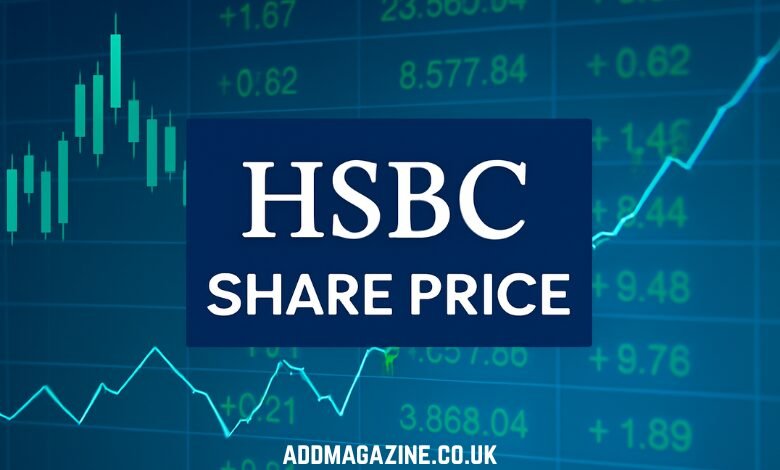HSBC Holdings plc (LSE: HSBA), one of the largest and most well-known banking and financial services organizations in the world, has seen considerable fluctuations in its share price over recent years. The share price of HSBC has been influenced by a combination of global market conditions, investor sentiment, and the bank’s financial performance. In this article, we’ll take a closer look at the factors that impact HSBC’s share price, its recent performance, and what investors might expect going forward.
What is HSBC?
HSBC is a British multinational bank, headquartered in London. It provides a wide range of banking and financial services, including retail banking, commercial banking, investment banking, wealth management, and global markets. HSBC has a strong presence in key global markets, with operations spanning across Asia, Europe, North America, and Latin America. The company’s size and global reach make it a significant player in the global banking sector.
HSBC’s share price is an important metric for investors, as it provides insights into the company’s financial health, market sentiment, and overall outlook. Like all publicly traded companies, HSBC’s share price fluctuates based on several factors, including economic conditions, corporate earnings, geopolitical events, and broader market trends.
Performance of HSBC Share Price
The share price of HSBC has seen significant movement over the years. In 2021, the price of HSBC shares remained relatively stable despite the challenges posed by the COVID-19 pandemic. However, as the global economy began to recover in 2022, HSBC’s share price started to show more promise.
In September 2023, HSBC’s share price saw a notable jump of over 10%. This outperformance was particularly striking when compared to the FTSE 100 index, which only rose by 1.4% over the same period. Several factors contributed to this surge in HSBC’s share price, making it an interesting stock to watch.
Factors Influencing HSBC’s Share Price
1. Technology and Innovation
One of the key stories driving HSBC’s recent performance was the news of a groundbreaking trial with IBM. The bank collaborated with IBM to use quantum computing algorithms in a world-first trial aimed at improving the efficiency of trading. Initial results indicated a 34% improvement in predicting bond trade execution compared to traditional methods.
While the full-scale implementation of such advanced technologies is still some way off, the trial demonstrated HSBC’s commitment to staying at the forefront of technological innovation in banking. This can signal a competitive advantage in trading infrastructure and could excite investors, who see this as a sign that the bank is embracing cutting-edge solutions to maintain its market edge.
2. Share Buybacks
Another contributing factor to the rise in HSBC’s share price is the bank’s ongoing share buyback program. HSBC has committed to a multi-billion-pound buyback initiative, which signals that the bank is confident in its financial standing and believes its shares are undervalued.
When a company repurchases its own shares, it reduces the number of shares in circulation, thereby increasing the value of the remaining shares. This often leads to a positive feedback loop, where other investors are encouraged to buy into the stock, further pushing the price up. HSBC’s buybacks suggest that the management believes in the long-term value of the company, boosting investor confidence.
3. Leadership Transition
However, there are also challenges facing HSBC that could affect its share price in the near future. The bank’s chairman, Mark Tucker, announced his resignation earlier than expected, which has created a leadership vacuum at the top. While the management team has been aware of this for a few months, a permanent replacement has yet to be found.
Leadership transitions can often lead to uncertainty, and in this case, the lack of a clear successor may cause investor concern, especially given the importance of strategic leadership in such a large global institution. If the leadership vacuum is not addressed swiftly, it could put downward pressure on the share price in the short term.
4. Interest Rate Environment
Another factor that could impact HSBC’s share price is the global interest rate environment. Central banks around the world, particularly the US Federal Reserve, have been lowering interest rates in recent months to support economic recovery. While lower interest rates can stimulate economic activity, they also pose a challenge for banks like HSBC.
Banks typically make money from the difference between the interest rate they charge on loans and the interest rate they pay on deposits. When interest rates are low, this profit margin, known as the net interest margin, tends to shrink. A prolonged low-interest-rate environment could negatively affect HSBC’s profitability, potentially leading to a decrease in its share price.
5. Valuation and Price-to-Earnings Ratio
One of the most attractive aspects of HSBC’s share price is its valuation. As of September 2023, the price-to-earnings (P/E) ratio for HSBC was 11.24. This is relatively low compared to the average P/E ratio for companies listed on the FTSE 100, which is around 16.
A lower P/E ratio suggests that the stock may be undervalued, which could present an opportunity for investors. However, while it is below the market average, it is also slightly above the benchmark fair value figure of 10, which could suggest that the stock has limited upside before reaching overvaluation. As a result, investors might want to keep a close eye on the stock’s performance to assess when it becomes too expensive to hold.
Risks to HSBC’s Share Price
1. Geopolitical Risks
Given HSBC’s global presence, geopolitical events can have a significant impact on its share price. For instance, political instability, trade disputes, or changes in regulation in key markets such as China, the US, or the UK could influence the bank’s operations and profitability. While HSBC has a diversified portfolio of assets and operations across multiple regions, exposure to geopolitical risks remains a challenge for global banks.
2. Regulatory Risks
HSBC is subject to regulation by various authorities around the world, including the UK’s Financial Conduct Authority (FCA), the US Federal Reserve, and the Hong Kong Monetary Authority. Changes in regulatory frameworks or compliance requirements could impact the bank’s operations or lead to additional costs. For instance, stricter capital requirements, changes in tax laws, or new financial regulations could potentially affect the bank’s profitability and, by extension, its share price.
3. Economic Slowdown
HSBC’s performance is also linked to the overall health of the global economy. If there is an economic slowdown, reduced consumer spending, lower demand for loans, or a downturn in financial markets, the bank’s profitability could be negatively impacted. As a result, a global economic downturn could weigh on HSBC’s share price, as investors would likely seek safer, less volatile investments.
Outlook for HSBC Share Price
Looking ahead, the outlook for HSBC’s share price remains mixed. The bank’s commitment to innovation, its ongoing share buybacks, and its relatively low valuation make it an attractive stock for long-term investors. However, risks such as leadership transitions, geopolitical tensions, and the low-interest-rate environment are potential challenges that could put pressure on the stock in the short term.
Given its strong financial position, global reach, and focus on technological innovation, HSBC is well-positioned to weather economic challenges and continue to grow over the long term. Investors who are considering adding HSBC to their portfolios should carefully monitor the bank’s performance, keeping an eye on key developments such as interest rates, leadership changes, and the overall economic environment.
HSBC’s Position in the Global Market
HSBC is one of the largest banks in the world, with a significant presence in key international markets, particularly Asia, Europe, and the Americas. This geographical diversification helps buffer the bank from adverse conditions in any single market and provides opportunities for growth in emerging markets, where banking penetration is still relatively low compared to more developed regions.
For example, HSBC’s strong presence in Asia is one of the cornerstones of its operations. The bank has been able to capitalize on the growing demand for banking services in regions such as Hong Kong, China, and Southeast Asia. In these markets, HSBC offers everything from retail banking and mortgages to trade finance and investment banking services.
China, in particular, has been a significant driver of growth for HSBC, and the country’s economic outlook has a direct impact on the bank’s future performance. As China continues to modernize its economy, HSBC’s focus on the region provides it with a competitive edge, especially in areas such as international trade and cross-border finance.
Moreover, HSBC’s focus on digital banking and technology-driven services has helped it stay competitive in the rapidly evolving financial services sector. The bank’s investments in digital transformation, including mobile banking apps, AI-powered financial advisory services, and automation in trading and customer support, are paving the way for future growth and efficiency gains.
HSBC’s Financial Performance
Looking at HSBC’s recent financial performance, the bank has posted solid results over the past few quarters. The bank reported a strong set of earnings for the first half of 2023, with higher profits driven by increased revenues from its global banking and markets division. However, much of this growth has been fueled by cost-cutting measures and improvements in operational efficiency, rather than top-line revenue growth. This means that HSBC has become more efficient in managing its resources, but its ability to generate significant organic growth is still a point of focus.
Another key highlight in HSBC’s performance is its capital strength. The bank has maintained a solid capital position, which is crucial for its long-term stability and ability to absorb shocks. HSBC’s Tier 1 capital ratio—a key measure of a bank’s financial health—has been strong, ensuring that it is well-positioned to weather any potential economic downturns. This robust capital position has been a significant driver of confidence among investors, contributing to its rising share price.
The Role of HSBC’s Dividends
For many investors, dividends play a key role in their decision to invest in a company. HSBC has a long history of paying dividends, and its dividend yield is often seen as one of the attractive features of the stock. The bank’s commitment to maintaining dividend payments, even during periods of market volatility, has helped establish its reputation as a reliable dividend payer.
However, it’s important to note that dividends are always subject to the bank’s financial health. If HSBC’s profitability takes a hit or if the broader economic environment weakens significantly, there could be a risk of dividend cuts. For investors, particularly those seeking steady income from their investments, it’s essential to monitor HSBC’s dividend policy and its ability to maintain these payments.
HSBC and Environmental, Social, and Governance (ESG) Factors
Another area that has gained increasing attention among investors is HSBC’s approach to environmental, social, and governance (ESG) factors. ESG investing has become a critical aspect of evaluating companies in recent years, with investors increasingly looking for firms that are not only financially sound but also socially responsible.
HSBC has made significant strides in this area, with the bank committing to net-zero emissions by 2050. The bank’s strategy includes financing sustainable projects, reducing its own carbon footprint, and aligning its investments with ESG principles. For example, HSBC has pledged to invest $1 billion to help accelerate the transition to a green economy, focusing on sustainable infrastructure and renewable energy projects.
Additionally, HSBC has taken steps to improve diversity and inclusion within the organization, which has further strengthened its ESG profile. The bank has introduced various programs aimed at increasing gender equality and promoting racial diversity in its workforce.
Investors are increasingly factoring ESG considerations into their decision-making processes, and HSBC’s strong performance in this area could attract socially-conscious investors, further boosting its share price.
Competitor Comparison: HSBC vs Other Major Banks
While HSBC is one of the largest banks in the world, it faces competition from other global banking giants such as JPMorgan Chase, Bank of America, and Citigroup. Each of these competitors has its strengths and weaknesses, but HSBC stands out with its deep ties to Asia and the broader emerging markets.
JPMorgan Chase, for example, has a dominant presence in the US and a much larger footprint in the investment banking sector. Similarly, Bank of America’s focus on retail banking in the US has made it a major player in that market. However, HSBC’s focus on international trade and its significant operations in Hong Kong and mainland China provide it with unique growth opportunities in markets that are still growing at a rapid pace.
When comparing HSBC to its peers, it’s clear that the bank’s performance will largely depend on its ability to leverage its Asian markets and its ongoing investments in technology. While the bank’s valuation may be lower than its peers, it has the potential to offer investors long-term growth, especially if it successfully capitalizes on the growth of digital banking and sustainable finance.
HSBC’s Future Prospects
Looking forward, HSBC’s share price will likely continue to be driven by several factors. These include its ability to generate revenue growth in key markets, particularly in Asia, and its capacity to maintain strong operational efficiency. The ongoing digital transformation within the bank will also play a crucial role in its future success.
The integration of advanced technologies such as artificial intelligence and blockchain into HSBC’s operations could also open up new avenues for growth. These technologies can improve everything from fraud detection to customer service, providing the bank with a competitive edge in an increasingly digital world.
Moreover, HSBC’s commitment to sustainable finance, combined with its focus on ESG factors, could help it attract a new generation of investors who prioritize social and environmental responsibility. This aligns with the growing global trend toward sustainable investing and could further bolster HSBC’s reputation in the market.
However, risks such as geopolitical instability, regulatory changes, and interest rate fluctuations still pose challenges to the bank’s outlook. For instance, HSBC’s profitability could be negatively impacted by ongoing trade tensions, particularly between the US and China, or by changes in monetary policy that affect global interest rates.
Conclusion
HSBC’s share price has experienced a notable rally in recent months, driven by a combination of innovative technological developments, strong capital positioning, and ongoing share buybacks. However, the bank faces challenges related to leadership changes, regulatory risks, and the broader economic environment.
While the stock is trading at a relatively low price-to-earnings ratio, making it appear undervalued, it is essential for investors to closely monitor key factors that could influence the bank’s performance. The increasing importance of ESG factors, digital banking, and the bank’s strategic presence in Asia will play a significant role in shaping HSBC’s long-term prospects.
For investors, HSBC remains an attractive option, but it is crucial to stay informed about the bank’s ongoing developments and market conditions to assess when to enter or exit the stock. In the end, HSBC’s share price could continue to rise if the bank successfully navigates its challenges and capitalizes on opportunities in the rapidly evolving global financial landscape.




